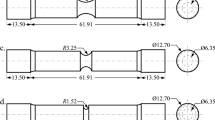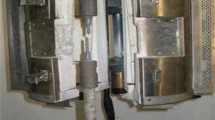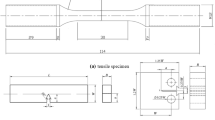Abstract
This paper proposes a methodology for the prediction of ductile fracture observed in steel specimens during tension tests at elevated temperatures. This methodology consists of two steps. First, true stress–strain curves that include the post-necking response are developed at both ambient and elevated temperatures. Second, a stress-modified critical strain (SMCS) fracture model is calibrated and utilized to model the ductile fracture behavior of structural steels exposed to elevated temperatures. Development of true stress–strain curves and calibration of SMCS fracture model parameters are based on the tension tests data of ASTM A992 steel tension specimen together with the simulation results of the tested tension specimens in Abaqus at elevated temperatures. The developed true stress–strain curves and fracture model parameters are further validated against the additional test results of ASTM A992 steel in tension that were not used in the calibration of the fracture models. Sensitivity analysis on fracture prediction considering the effect of the mesh size and the variation of fracture model parameters are investigated. The analysis results suggest that the predicted fracture initiation strain is mildly sensitive to the effect of mesh size and variation of fracture model parameters. The robustness and limitations of the proposed methodology in predicting ductile fracture at elevated temperatures were further investigated. Overall, the developed methodology for ductile fracture in tensile specimens of ASTM A992 steel was demonstrated to reasonably predict tensile fracture at temperatures up to 1000°C.

















Similar content being viewed by others
References
Calobrezi GC, Silva VP (2020) On the local buckling of steel “I” profiles in a fire situation. Fire Technol. https://doi.org/10.1007/s10694-020-01009-6
Al Haddad HO, Hantouche EG, Al Khatib KK (2019) Numerical studies on the creep behavior of shear endplate connection assemblies under transient heating. Fire Technol 55:2341–2367. https://doi.org/10.1007/s10694-019-00869-x
Dwaikat M, Kodur V (2010) Effect of location of restraint on fire response of steel beams. Fire Technol 46:109–128. https://doi.org/10.1007/s10694-009-0085-9
Kucukler M (2020) Lateral instability of steel beams in fire: behaviour, numerical modelling and design. J Constr Steel Res 170:106095. https://doi.org/10.1016/j.jcsr.2020.106095
Mohammed A, Afshan S (2019) Numerical modelling and fire design of stainless-steel hollow section columns. Thin-Walled Struct 144:106243. https://doi.org/10.1016/j.tws.2019.106243
Lou G, Wang C, Jiang J, Jiang Y, Wang L, Li GQ (2018) Experimental and numerical study on thermal-structural behavior of steel portal frames in real fires. Fire Saf J 98:48–62. https://doi.org/10.1016/j.firesaf.2018.04.006
Kotsovinos P, Atalioti A, Mcswiney N, Lugaresi F, Sadowski AJ (2020) Analysis of the thermomechanical response of structural cables subject to fire. Fire Technol 56:515–543. https://doi.org/10.1007/s10694-019-00889-7
Cai W (2015) Steel fracture modeling at elevated temperature for structural-fire engineering analysis. Dissertation, University of Texas at Austin
ASTM A992/A992M, Standard Specification for Structural Steel Shapes (2015) ASTM International, West Conshohocken, Pennsylvania
Anderson TL (2017) Fracture mechanics—fundamentals and applications. CRC Press
Zhu Y, Engelhardt MD (2018) Prediction of ductile fracture for metal alloys using a shear modified void growth model. Eng Fract Mech 190:491–513. https://doi.org/10.1016/j.engfracmech.2017.12.042
McClintock FA (1968) A criterion for ductile fracture by the growth of holes. J Appl Mech 1(2):363–371. https://doi.org/10.1115/1.3601204
Rice JR, Tracey DM (1969) On the ductile enlargement of voids in triaxial stress fields. J Mech Phys Solids 17(3):201–217. https://doi.org/10.1016/0022-5096(69)90033-7
Hancock JW, Mackenzie AC (1976) On the mechanisms of ductile failure in high-strength steels subjected to multi-axial stress-states. J Mech Phys Solids 24(2–3):147–160. https://doi.org/10.1016/0022-5096(76)90024-7
Gurson AL (1977) Continuum theory of ductile rupture by void nucleation and growth: part I—Yield criteria and flow rules for porous ductile media. J Eng Mater Technol 99(1):2–15. https://doi.org/10.1115/1.3443401
Hancock JW, Brown DK (1983) On the role of strain and stress state in ductile failure. J Mech Phys Solids 31(1):1–24. https://doi.org/10.1016/0022-5096(83)90017-0
Tvergaard V, Needleman A (1984) Analysis of the cup-cone fracture in a round tensile bar. Acta Metall 32(1):157–169. https://doi.org/10.1016/0001-6160(84)90213-X
Johnson GR, Cook WH (1985) Fracture characteristics of three metals subjected to various strains, strain rates, temperatures and pressures. Eng Fract Mech 21(1):31–48. https://doi.org/10.1016/0013-7944(85)90052-9
Bao Y, Wierzbicki T (2004) On fracture locus in the equivalent strain and stress triaxiality space. Int J Mech Sci 46(1):81–98. https://doi.org/10.1016/j.ijmecsci.2004.02.006
Hooputra H, Gese H, Dell H, Werner H (2004) A comprehensive failure model for crashworthiness simulation of aluminum extrusions. Int J Crashworthiness 9(5):449–464. https://doi.org/10.1533/ijcr.2004.0289
Myers AT, Kanvinde AM, Deierlein GG (2010) Calibration of the SMCS criterion for ductile fracture in steels: specimen size dependence and parameter assessment. J Eng Mech ASCE 136(11):1401–1410. https://doi.org/10.1061/(ASCE)EM.1943-7889.0000178
Kiran R, Khandelwal K (2013) A micromechanical model for ductile fracture prediction in ASTM A992 steel. Eng Fract Mech 102:101–117. https://doi.org/10.1016/j.engfracmech.2013.02.021
Jia LJ, Kuwamura H (2014) Ductile fracture simulation of structural steels under monotonic tension. J Struct Eng ASCE 140(5):04013115. https://doi.org/10.1061/(ASCE)ST.1943-541X.0000944
Khandelwal K, El-Tawil S (2014) A finite strain continuum damage model for simulating ductile fracture in steels. Eng Fract Mech 116:172–189. https://doi.org/10.1016/j.engfracmech.2013.12.009
Kanvinde AM, Deierlein GG (2006) The void growth model and the stress modified critical strain model to predict ductile fracture in structural steels. J Struct Eng ASCE 132(12):1907–1918. https://doi.org/10.1061/(ASCE)0733-9445(2006)132:12(1907)
Kanvinde AM, Deierlein GG (2007) Cyclic void growth model to assess ductile fracture initiation in structural steels due to ultra-low cycle fatigue. J Struct Eng ASCE 133(6):701–712. https://doi.org/10.1061/(ASCE)0733-9399(2007)133:6(701)
Cai W, Morovat MA, Engelhardt MD (2017) True stress-strain curves for ASTM A992 steel for fracture simulation at elevated temperatures. J Constr Steel Res 139(12):272–279. https://doi.org/10.1016/j.jcsr.2017.09.024
Lee J, Morovat MA, Hu G, Engelhardt MD, Taleff EM (2013) Experimental investigation of mechanical properties of ASTM A992 steel at elevated temperatures. Eng J AISC 50(4):249–272
Abaqus/Standard Version 6.12 User’s Manual (2012) Providence, RI
Morovat MA (2014) Creep buckling behavior of steel columns subjected to fire. Dissertation, University of Texas at Austin, Austin
Abaqus/Explicit Version 6.12 User’s Manual (2012) Providence, RI
Acknowledgements
The research reported herein was made possible through previous funding from the National Science Foundation for research projects on Elevated Temperature Performance of Beam End Framing Connections, on Creep Buckling of Steel Columns Subjected to Fire and on Elevated Temperature Performance of Shear Connectors for Composite Beams, (NSF Awards 0700682, 0927819 and 1031099, respectively). The support of the National Science Foundation and of the former NSF Program Directors M.P. Singh and Douglas Foutch is gratefully acknowledged. Any opinions, findings, and conclusions or recommendations expressed in this paper are those of the authors and do not reflect the views of the National Science Foundation.
Author information
Authors and Affiliations
Corresponding author
Additional information
Publisher's Note
Springer Nature remains neutral with regard to jurisdictional claims in published maps and institutional affiliations.
Rights and permissions
About this article
Cite this article
Cai, W., Morovat, M.A., Engelhardt, M.D. et al. Ductile Fracture in ASTM A992 Steel Tensile Specimens at Elevated Temperatures. Fire Technol 58, 1417–1443 (2022). https://doi.org/10.1007/s10694-021-01209-8
Received:
Accepted:
Published:
Issue Date:
DOI: https://doi.org/10.1007/s10694-021-01209-8




